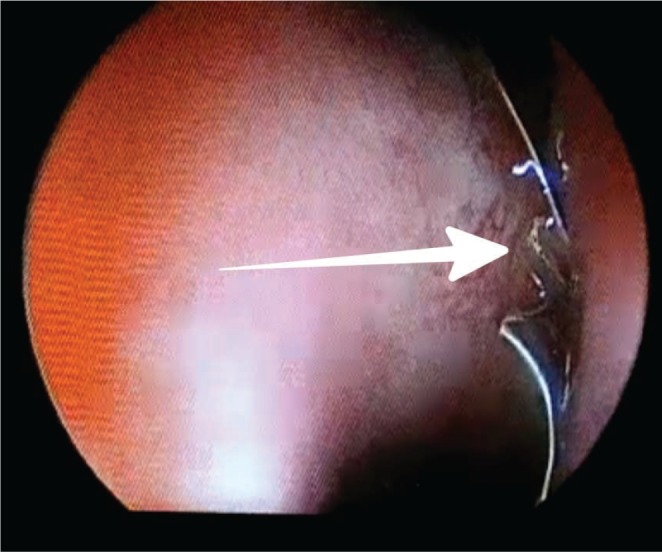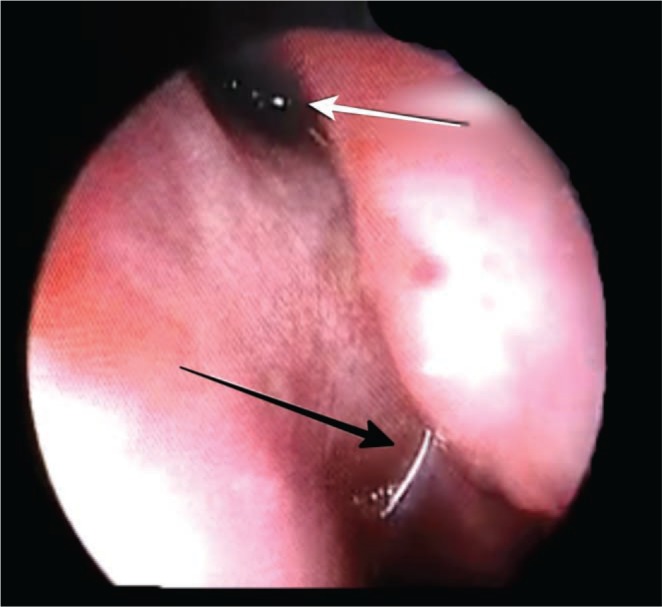Neurointervention.
2018 Mar;13(1):66-69. 10.5469/neuroint.2018.13.1.66.
Delayed Endovascular Coil Extrusion Presenting as a Foreign Body of the Throat: a Case Report
- Affiliations
-
- 1Department of Otorhinolaryngology and Head and Neck Surgery, All India Institute of Medical Sciences, New Delhi, India. kapil_sikka@yahoo.com
- 2Department of Neuroimaging and Interventional Neuroradiology, All India Institute of Medical Sciences, New Delhi, India.
- KMID: 2424053
- DOI: http://doi.org/10.5469/neuroint.2018.13.1.66
Abstract
- Endovascular treatment is a standard mode of treatment for traumatic cavernous internal carotid artery (ICA) pseudoaneurysms with good results and relatively low rates of complications. We describe a case of an unusual, potentially fatal, delayed postoperative event happening in a case of post-traumatic pseudoaneurysm of ICA, which had been previously managed with endovascular coiling.
Keyword
Figure
Reference
-
1. Chen D, Concus AP, Halbach VV, Cheung SW. Epistaxis originating from traumatic pseudoaneurysm of the internal carotid artery: diagnosis and endovascular therapy. Laryngoscope. 1998; 108:326–331. PMID: 9504602.
Article2. Higashida RT, Halbach VV, Dowd CF, Barnwell SL, Hieshima GB. Intracranial aneurysms: interventional neurovascular treatment with detachable balloons-results in 215 cases. Radiology. 1991; 178:663–670. PMID: 1994399.
Article3. Maras D, Lioupis C, Magoufis G, Tsamopoulos N, Moulakakis K, Andrikopoulos V. Covered stent-graft treatment of traumatic internal carotid artery pseudoaneurysms: a review. Cardiovasc Intervent Radiol. 2006; 29:958–968. PMID: 16897263.
Article4. Levy E, Koebbe CJ, Horowitz MB, Pride GL, Dutton K, et al. Rupture of intracranial aneurysms during endovascular coiling: management and outcomes. Neurosurgery. 2001; 49:807–811. PMID: 11564240.
Article5. Akan H, Belet U, Enel A. Coil-Induced Perforation of Recently Ruptured Cerebral Aneurysm during Embolization. Causes and Avoidance. Interv Neuroradiol. 2003; 9:83–88.
- Full Text Links
- Actions
-
Cited
- CITED
-
- Close
- Share
- Similar articles
-
- Delayed cranial nerve palsy after successful coil embolization in cavernous sinus lesion
- Oral Extrusion of Screw after Anterior Cervical Interbody Fusion
- Extrusion of Gutta-Percha into the Nasal Cavity Causing Maxillary Fungal Sinusitis: A Case Report
- Acute frame coil migration during filling coil retrieval in a cerebral aneurysm embolization case: A possible result of a venturi effect?
- Delayed Herniation of Coil Loop and Spontaneous Reposition in a Superior Cerebellar Artery Aneurysm






